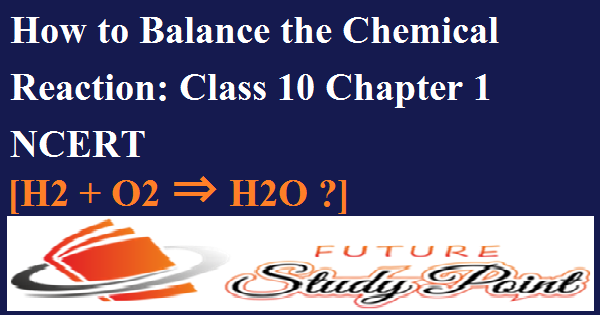How to Balance the Chemical Reaction: Class 10 Chapter 1 NCERT
How to Balance the Chemical Reaction: Class 10 Chapter 1 NCERT
It is the conservation of the mass due to which we need to balance a chemical reaction, to balance a chemical reaction is very easy,if so far you don’t know how to balance it, then go through the whole post, you will definitely become capable to balance the chemical reaction jus know.
Before, we go through the post, let us discuss few important points why is the balance of the chemical reaction needed and why did chemical reaction occured between two substances.
One atom of a substance react to atom of other substance to fulfill the the no. of electrons in their outermost orbital,every atom has a tendency to have a octate of electrons in its outermost orbital,for acheiving this one substance reacts with other substance.
The chemical reaction between two substances results in the formation of new products, according to the law of conservation of the mass, the mass of reactants is always equal to the mass of products during a chemical reaction. The products are formed in a chemical reaction by the exchange of ions or atoms following the rule of constant proportion.
The law of constant proportion states that the atoms in a molecule are always combined in a fixed proportion,as an example in water (H2O), the mass of hydrogen is 2×1 =2u, and the mass of oxygen is 8u, so the ratio of the hydrogen and oxygen in water is always 1: 8 whether water is found anywhere in the universe and in any form gas, liquid and solid.
How to Balance the Chemical Reaction: Class 10 Chapter 1 NCERT
We can understand it by the following example.
H2 + O2 ⇒ H2O
Step 1: First of all count the no. of atoms of the elements in LHS and RHS , as in the above chemical reaction in LHS the no. of hydrogen atoms is 2 and in RHS the no. of atoms of hydrogen is 2, therefore hydrogen atoms are not needed to balance because they are equal in both sides.
Step 2: Now, observing the no. of oxygen atoms in LHS, these are 2. In RHS the no. of oxygen atoms is 1, therefore for balancing the oxygen atom we are needed to change the single water molecules to 2 water molecules in RHS so that there could be 2 oxygen atoms.
H2 + O2 ⇒ 2H2O
Step 3: Finally, once again let us check the no. of hydrogen and oxygen atoms in LHS and RHS, we find the no. of hydrogen in RHS is 4 and 2 hydrogen atoms in LHS, therefore for balancing the hydrogen atoms we are needed to change the single hydrogen molecule to 2 hydrogen molecules in LHS so that there could be 4 hydrogen atoms.
2H2 + O2 ⇒ 2H2O
It is the required balance chemical reaction because in LHS and RHS there are equal no. of hydrogen and oxygen atoms.
Example 2: Balance the chemical reaction:Fe + H2O⇒ Fe3O4+ H2
Step 1: In LHS iron atoms are 1 and in LHS these are 3,therefore changing the 1 iron atom to 3 iron atom in LHS
3Fe + H2O⇒ Fe3O4+ H2
Step 2: In LHS there is 1 oxygen atoms and in RHS these are 4,therefore changing the 1 water molecule to 4 water molecules in LHS such that in LHS no. of oxygen atoms become 4.
3Fe + 4H2O⇒ Fe3O4+ H2
Step 3: Now ,we see that in LHS there are 8 hydrogen atoms and in RHS these are 2,therefore changing the 1 hydrogen molecule to 4 hydrogen molecules in RHS such that in RHS no. of hydrogen atoms become 8
3Fe + 4H2O⇒ Fe3O4+ 4H2
It is a required balance chemical reaction no. of the atoms of each elements are equal in both sides.
You can also study
Why does the Sun appears reddish in the evening and morning: Complete Detail
Why do calcium and magnesium float on the surface of the water?
What is the importance of hormones?,
What is the difference between solution,colloid and suspension?,
What is the difference between element and the compound?,
What is the difference between the homologous and analogous structure of organs,
What is the difference between virtual and real images?,
What are the factors affecting evaporation?,
Important Science Notes
Image formation by Convex and Concave Mirrors,
Image formation by Convex and Concave Lenses,
Image formation by Convex and Concave Mirrors,
Difference between Convex and Concave lenses,
Functioning of Soda-Acid Fire Extinguisher,
What are Corrosion and Rancidity ?,
Structure and Function of Cell : Cell Biology,
Archimedes Principle: Complete detail,
Average Speed and Average velocity,
The universal law of gravitational force,
Thrust and Pressure : Difference,
Evoporation,Vapourization and Latent heat,
Important salts class 10 CBSE sceience notes,
Reflection, Refraction, Dispersion, and Scattering,
Atom, Molecule, and Atomicity,
Determining Valency, Net Charge and Molecular Formula,
Ozone Layer and How it is Getting depleted.,
Human Eye – Structure and functions ,
Myopia, Hypermetropia, and Presbyopia,
Electric Current and Heating effect of Electric Current,
Complete detail of electrical resistance and conductance,
Type of Chemical Reactions with Complete detail,
Class 10 chemistry Viva Voce Questions and Answers for CBSE Board 2020-21,
What are the physical and chemical properties of metals?,




